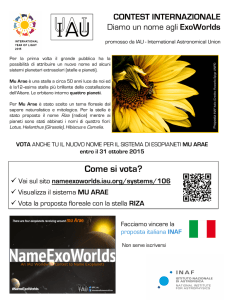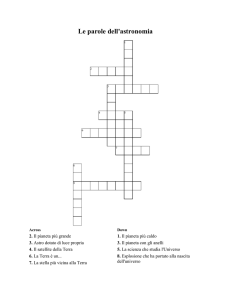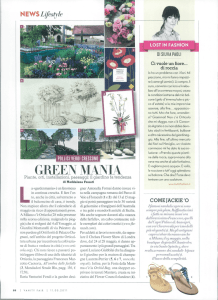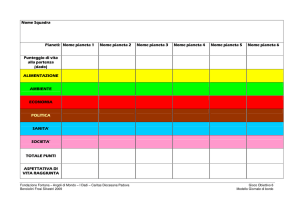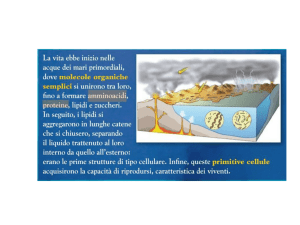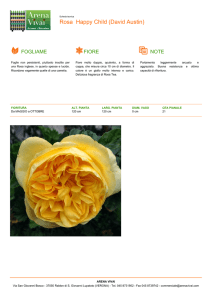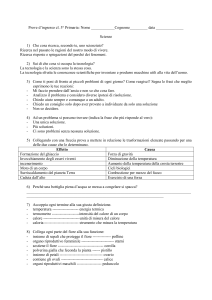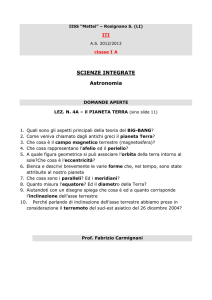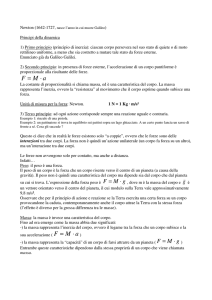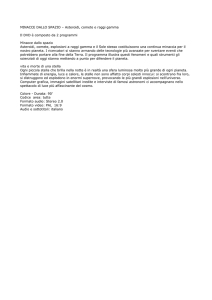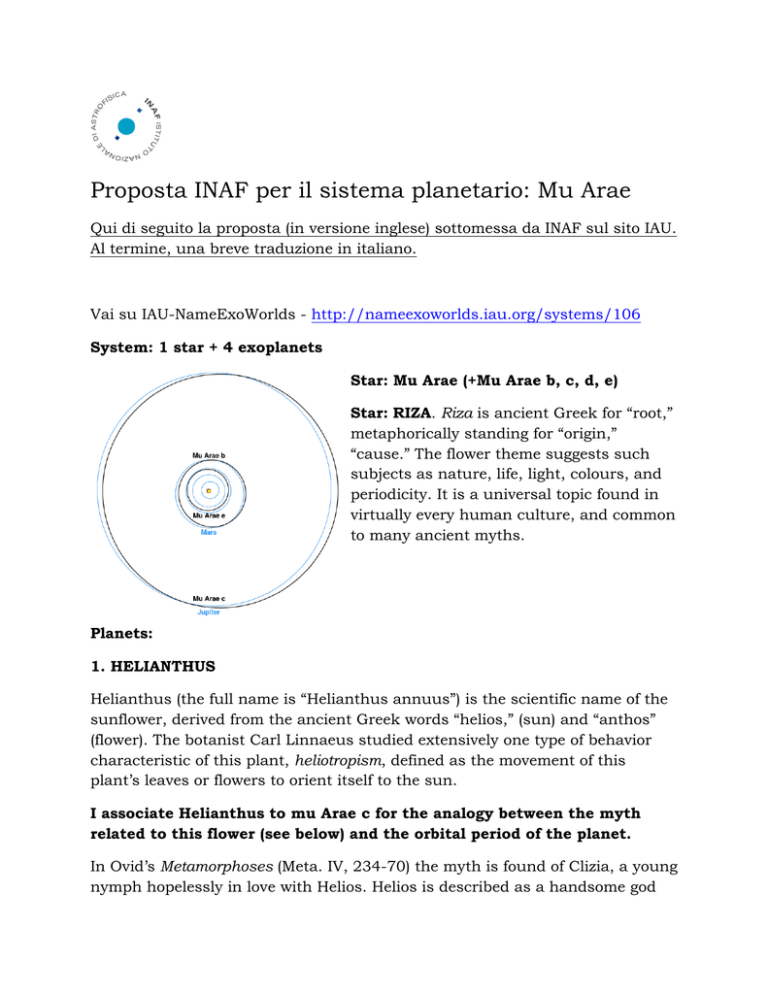
Proposta INAF per il sistema planetario: Mu Arae
Qui di seguito la proposta (in versione inglese) sottomessa da INAF sul sito IAU.
Al termine, una breve traduzione in italiano.
Vai su IAU-NameExoWorlds - http://nameexoworlds.iau.org/systems/106
System: 1 star + 4 exoplanets
Star: Mu Arae (+Mu Arae b, c, d, e)
Star: RIZA. Riza is ancient Greek for “root,”
metaphorically standing for “origin,”
“cause.” The flower theme suggests such
subjects as nature, life, light, colours, and
periodicity. It is a universal topic found in
virtually every human culture, and common
to many ancient myths.
Planets:
1. HELIANTHUS
Helianthus (the full name is “Helianthus annuus”) is the scientific name of the
sunflower, derived from the ancient Greek words “helios,” (sun) and “anthos”
(flower). The botanist Carl Linnaeus studied extensively one type of behavior
characteristic of this plant, heliotropism, defined as the movement of this
plant’s leaves or flowers to orient itself to the sun.
I associate Helianthus to mu Arae c for the analogy between the myth
related to this flower (see below) and the orbital period of the planet.
In Ovid’s Metamorphoses (Meta. IV, 234-70) the myth is found of Clizia, a young
nymph hopelessly in love with Helios. Helios is described as a handsome god
crowned with the shining halo of the sun, who drove the chariot of the sun
across the sky every day. As Clizia’s love was not reciprocated by Helios, she
was reduced to watching him from afar plow the sky with the sun’s chariot,
and weeping for her impossible passion. In the myth she cries and starves
herself for NINE DAYS, only quenching her tears and dew drops on leaves. All
the while her body gradually turns into a flower stalk, her face in the end
becoming a sunflower that follows her loved one from sunrise to sunset, as the
symbol of an impossible love and an eternal fidelity.
2. HIBISCUS
It is considered a symbol of fleeting and delicate beauty, because its beautiful
blossom has a lifespan of just a day. Hibiscus flowers can appear white in the
morning, turning pink at noon and red in the evening of the same day.
The hibiscus is the official flower of the Hawaiian Islands, its diverse varieties
and colors representing the different islands.
I associate Hibiscus to mu Arae d for the analogy between the delicate
beauty of the flower and the relative small size of the planet (mu Arae d is
really small compared to the other planets of the system: mu Arae c is
thought to be developed from a gas giant, losing most of its mass on the way).
3. CAMELLIA
Camellia stands for faithfulness and longevity in the language of flower, living more
than a century. Camellias flower in late winter and early spring, but there are some
that flower in late autumn, from November until January, illuminating with their
white, pink and red flowers.
I associate Camellia to mu Arae e for the analogy between the climate in
which the flower grows and the temperature of the planet and because the
flower is large, just as the planet is massive.
4. LOTUS
The lotus plant (water lily) blooms in the morning and its petals fall in the
afternoon. The ancient Egyptians observed that the lotus flower disappeared
during the night only to reappear in the morning, thus associating it with the
rebirth of the sun. In many cultures the lotus flower symbolizes beauty, purity,
and life, as well as the union of the earth and the sky.
I associate Lotus to mu Arae b for the analogy between the symbolic
meaning of the flower (life) and the fact that the planet orbits in the
habitable zone of the system.
By Rossella Spiga
University of Padova – Italy
Mu Arae è una stella molto simile al Sole, solo un po' più grande (sia in raggio che in
massa), e si trova nell'emisfero australe a circa 50 anni luce da noi.
Si conoscono ben quattro pianeti che orbitano attorno a Mu Arae, tre dei quali di tipo
gioviano, cioè giganti gassosi con periodi orbitali rispettivamente di 0,8, 1,7 e 11,3
anni.
Molto più vicino alla stella, con un periodo orbitale di soli 9,5 giorni, si trova un
pianeta molto più piccolo, probabilmente roccioso, con una massa pari ad almeno 14
volte quella terrestre e con una temperatura che potrebbe essere vicina ai 600 gradi
centigradi.
Stella: RIZA. Riza è la parola greca che indica “radice”, metaforicamente “origine”,
“causa”. Il tema floreale offre la suggestione di importanti temi: la Natura, la Vita, la
Periodicità, la Luce, i Colori. E' un tema universale presente in ogni cultura, legato
molto spesso alla mitologia e alla simbologia.
Pianeti:
1. HELIANTHUS - GIRASOLE
Helianthus Annuus è il nome scientifico che indica il Girasole. Il nome generico
(Helianthus) deriva da due parole greche ”helios” (= sole) e ”anthos” (= fiore) in
riferimento alla tendenza di questa pianta a girare sempre verso il sole,
comportamento noto come eliotropismo. Anche il nome comune italiano (Girasole)
deriva dalla rotazione in direzione del sole.
Il nome Heliantus è stato associato al pianeta mu Arae c considerata l'analogia tra il
periodo orbitale del pianeta e il mito legato a questo fiore (si veda sotto).
Il poeta latino Ovidio nelle Metamorfosi di (Meta. IV, 234-70) riporta l'antico mito
greco di Clizia, una giovane ninfa innamorata di Elios, Dio del sole che ogni giorno
solcava il cielo con un crocchio trainato da quattro cavalli. Clizia, spinta da un amore
incondizionato ma non ricambiato dal Dio Helios, passò giorni e nove notti Clizia
senza mangiare seguendo con lo sguardo il carro del Dio in cielo. Bevve soltanto le sue
lacrime e la rugiada dalle foglie, finchè il decimo giorno mise radici nel terreno, il suo
corpo si trasformò nello stelo di un fiore e il suo viso divenne fioritura. Clizia fu
trasformata in girasole, condannata a seguire il muoversi del sole nel cielo dall’alba al
tramonto, diventando simbolo dell'amore impossibile e dell'eterna fedeltà.
2. HIBISCUS - IBISCO
Viene considerato simbolo di una bellezza effimera e delicata, a causa della sua
bellissima fioritura della durata di un solo giorno. I fiori dell'Ibisco possono variare la
loro colorazione durante il giorno, apparendo bianchi la mattina e scarlatti la sera
dello stesso giorno.
L'Ibisco è il fiore nazionale delle Isole Hawaii.
Il nome Hibiscus è stato associato al pianeta mu Arae d per l'analogia tra la delicata
bellezza del fiore e le ridotte dimensioni del pianeta se comparato agli altri pianeti del
sistema (si ritiene che Arae d sia stato un pianeta gigante gassoso che ha perso la
maggior parte della sua massa).
3. CAMELLIA – CAMELIA
Data la notevole durata della vita della Camelia (anche un secolo), questo fiore è
diventato simbolo di lealtà e la longevità. La fioritura della Camelia avviene in inverno
o nel primo periodo primaverile, da novembre a gennaio, offrendo bellissimo fiori
bianchi, rosa e rossi.
Il nome Camelia è stato associato al pianeta mu Arae e per l'analogia tra il clima
freddo in cui vive la pianta e la temperatura del pianeta (il più lontano dalla stella).
L'analogia riguarda inoltre le dimensioni del grande fiore della Camelia e il pianeta
molto massiccio.
4. LOTUS – LOTO
Caratteristica dei fiori del Loto è quella di schiudersi la mattina e richiudersi il
pomeriggio. Già gli antichi Egizi avevano associato questo ciclo alla rinascita del Sole.
In molte culture il fiore di Loto rappresenta Bellezza, Purezza, Vita e la profonda
unione tra Terra e Cielo.
Il nome LOTO è stato associato al pianeta mu Arae b per l'analogia tra il significato
simbolico del fiore (la Vita) e il fatto che il pianeta orbita nella zona considerata
abitabile del sistema.
di Rossella Spiga
Università di Padova, Italia
La proposta INAF è disponibile sul sito NameExoWorlds insieme ad altre proposte:
http://nameexoworlds.iau.org/systems/106 .

